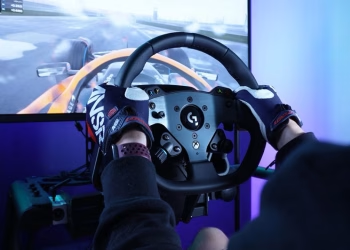When Joshua Cheptegei smashed the 10,000m world record on a warm Valencian night back in October 2020, many fans marvelled at the incredible speed he had set. His time of 26 minutes and 11 seconds beat the previous record by over six seconds and raised the famous race’s bar even higher.
But among all the fanfare and praise for his efforts, Cheptegei also had to deal with some controversy. Critics felt that Wavelight technology had helped him push himself that extra bit further – an advantage that generations of previous runners didn’t have.
To that end, is it right to lessen the achievements of runners due to this technology, or should we recognise their achievements just the same?
What is Wavelight Technology?
Wavelight works as a system of green and blue LED lights that are placed around the inside of the track. They are programmed to depict a record time in that race, be it the world record or a local achievement, so spectators and runners see them flash alongside the track at the record speed. A good way to see it is as a kind of pacesetter.
Pacesetters are nothing new, of course. Organisers have used pre-set ‘rabbits’ that move with the athletes to help them maintain a certain pace. In greyhound racing, the rabbit acts as a target for the dogs to chase.
The difference is that Wavelight removes any chance of human error with computers timing the lights down to the correct millisecond. What’s more, it’s the perfect way to boost fan engagement – seeing the athletes compete against the lights makes for a thrilling spectacle, as the recent spate of record-breaking efforts has proved.
A very modern advantage
It’s fitting that technology should play such a big role in creating the latest athletics controversy. Whereas in the past players faced doping scandals and accusations of unfair funding, the Wavelight debate feels like a very 21st century argument.
How it differs, though, is how it’s available to everyone. If a player uses performance-enhancing drugs, then he or she is only benefitting themselves. If a team receives a huge amount of funding, like Team GB have from the UK National Lottery (amongst others) over the last 25 years, then poorer nations can point at an unfair advantage over them.
Wavelight, however, helps an Ethiopian in the same way it would an Australian. Everyone can see the same lights, everyone knows how fast they’re going relative to the record, and everyone can push themselves that little bit more. The technology discriminates against no one during the race.
To further boost its credentials, Wavelight has received support from the highest ranks in the game. World Athletics President Seb Coe stated that he had ‘no problems’ with the system, insisting that it was important to create a connection with fans, especially new ones, and Wavelight was a great way of doing this. As a legendary runner himself, he believes the tech even shows how good the athletes are by how illustrating how close they get to the world record, time after time.
Other records broken under the gaze of Wavelight include the women’s 5,000m on the same night as Joshua Cheptegei and at the Diamond League meeting in Brussels last August, where Mo Farah and Sifan Hassan broke the men’s and women’s records respectively. Each time the athletes seemed very happy to use the tech to inspire them.
The argument against Wavelight
Not all the reaction to Wavelight has been positive, though. While it’s true that official events will have it in place, some have pointed out how only a few from the richest countries will have access to it in training.
Kenya’s Hellen Obiri, the sixth fastest female 5km runner in history, pointed out that not having the tech in preparations could lead to some athletes not being used to it in big events. She even compared it to doping, saying it gives some athletes a boost and not others.
Another criticism is that it gives modern runners an unfair advantage compared to those of the past. While this might be true, you could also say the same about modern running equipment, such as better sports shoes, and the higher-quality tracks that athletes use nowadays: so should we ban those?
The reality is that Wavelight looks set to stay, and we may see it contribute to more historic moments very soon.
Could more records be broken?
While Wavelight has contributed to a spate of single-day records, it hasn’t yet received approval to be used at the Olympics. The 2020 event, cancelled due to the pandemic, was deemed to be too soon for it, with the 2024 games in Paris the likely target.
Only then will we really start to see the influence of the technology as the world’s best runners gather to compete for the crowning glory of any athlete’s career – the Olympic gold medal.
At the last event in 2016, Almaz Ayana famously broke the women’s 10,000 metre record, but it was the only long-distance race to see its quickest run of all time. The men’s 3,000m steeplechase and women’s 5,000 metres were the only ones that achieved Olympic records.
The introduction of Wavelight could open the barriers to more record-breakers than ever in a single event. With the likes of Ayana and Kenya’s Conseslus Kipruto reaching their peak by that point, it might even be known as the ‘Wavelight Olympics’.









The wavelight technology was banned in the seventies. It’s an electronic aid. Should be banned now.